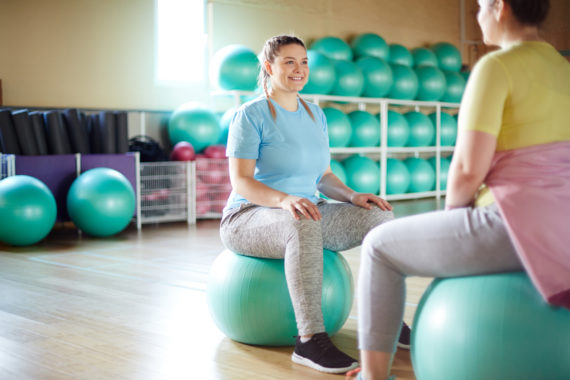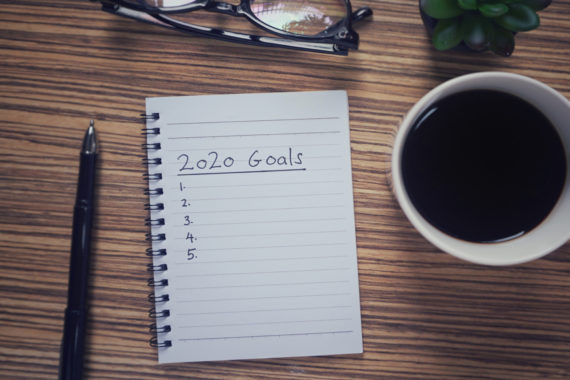Exercise is important for physical and mental well-being and its benefits extend way beyond the commonly known weight loss or muscle growth. Physical activity is as important for your body as mental activities like learning or reading is for the mind. There are a lot of myths about what exercise is and can be, so please use this section as a guide as you begin your journey to a healthier you.
Why Exercise

When beginning an exercise program, it’s important to figure out why you want to exercise in the first place. Before you start exercising, jot down your reasons for wanting to exercise. Some examples could be:
- I like the way exercise makes me feel… confident, strong, accomplished, less stress, energized, etc.
- Exercise helps improve my flexibility and balance.
- I want to stay active and healthy so I can be there for my family.
- I want to exercise to change my body composition.
- I want to run my first 5k.
Losing weight may be the most common ‘why’ many people exercise, but it’s not the only reason. If your goal is only moving numbers on a scale, you put yourself in jeopardy of giving up if you don’t see what you expect on the scale. Create a ‘why’ that is independent of your weight so you stay focused and motivated.
How to Exercise
After completing the critical step of finding reasons why you want to exercise, learn how to exercise correctly to avoid burnout or injury. Starting out too fast or too hard can be detrimental to your overall goal if you get hurt or think you can’t keep up with these new changes. Adding exercise to your plan is a lifestyle choice, not a quick fix.
Not everyone starts from the same place. If you have been sedentary or have very little exercise experience, then your first goal is to find an activity where you are simply moving your body and making it stronger whenever and wherever you can.
You don’t have to exercise in a gym or follow anyone else’s plan. Start simple and take the stairs when you can, get up and walk six minutes every hour, do standing squats, go for a walk at lunch, etc. — all movement counts! Over time you may want to try other types of activities like yoga or weightlifting or running, but don’t rush into it unless you’re ready or you may get overwhelmed and frustrated.
Over time you can build upon your previous successes by adding more time to your walks, more weights to your lifts, or adding an extra exercise class on the weekends. Don’t be afraid to push yourself.
Where to Exercise

There’s lots of good news for you if you aren’t sure where to go. The first thing to remember is that you can add extra activity anywhere in your typical routine with a few adjustments:
- Park farther away from your destination’s entrance.
- Walk rather than drive when possible.
- Add 5 minutes to your dog’s walk.
- Take 6 minutes every hour to stand up and move around.
- Take the stairs when possible.
- Use a wall for wall squats or pushups.
If you have a gym or exercise class that’s in your routine path you are lucky and might want to join a nearby gym or take classes. Keep in mind that the best way to start new habits is to make them fit into your day, so if you have to drive 20 min. out of your way, you may begin creating excuses for not going. Try to make your ‘where’ so convenient that you don’t even think about it as an effort. If you love going to a gym or a class, by all means do that, but the work you put in isn’t dependent on a specific ‘where’ – just do it!
When to Exercise
Whenever you can! A scientific debate over the best time to workout has been raging for decades with no provable conclusion, so the answer for you is simple: workout at whatever time works for you and your schedule. That’s the only way you’ll get it done.
If you’re not a morning person and normally run out the door every day, don’t commit to 5 a.m. workouts. If you’re exhausted after work, don’t plan on working out after dinner. This is just good sense. A trick to help you stick to your ‘when’ is to schedule your exercise time like you would any other appointment — get it on the calendar and be accountable for getting it done!
How Much to Exercise to Reach Your Goal

The question of how much you should exercise is only answerable upon evaluation of your goals, your schedule, and your fitness level. If you are a beginner, you want to start small and work your way to longer durations, regardless of the type of exercise or activity you have chosen. Here are a few guidelines that may help you determine how much exercise you should strive for when planning your goals.
Heart Health: If you are exercising to improve overall health and keep your heart healthy, the American Heart Association recommends at least 150 minutes per week of moderate-intensity aerobic activity or 75 minutes per week of vigorous aerobic activity. Examples of moderate-intensity include brisk walking, water aerobics, gardening, and biking slower than 10 mph. Vigorous activities can include hiking, running, swimming, and cycling faster than 10 mph. Monitoring your heart rate is a good way to gauge intensity. Your maximum heart rate should be close to 220 bpm minus your age in years. If you are 40, your maximum heart rate would be 180 bpm. Moderate intensity exercise should have the effect of 50-70% of your maximum heart rate and vigorous activity should reach 70-85% of your maximum heart rate.
Stress Management: When stress affects the brain, the rest of the body feels it as well, so if your body feels better from exercise, so does your brain. Exercise produces endorphins, which are chemicals in the brain that can act as natural pain killers, mood stabilizers, and can even help you sleep. These “feel good” hormones lead to less stress. Regular low-to-moderate intensity exercise is best to help lower stress levels. As little as five minutes of aerobic activity can help reduce anxiety and lower stress levels. Vigorous exercise too late in the day may interfere with sleep patterns in some individuals, so make sure to allow time to unwind if you have a more intense workout.
Weight Loss: The number one reason people exercise is to lose weight; however, lack of weight loss from exercise is also the number one reason people stop exercising. While 100% of the daily energy we gain comes from the foods we eat, only 10-30% of it is used for physical activity. Physical exercise does more than burn calories, it also can affect how much you eat and how many calories you use. Don’t expect to lose a lot of weight from exercise alone. Any solid exercise plan must accompany a healthy diet for it to impact your weight. Incorporating 30-60 minutes of moderate-to-vigorous activity daily while maintaining a healthy diet is the best strategy to improve overall health and make weight loss a healthy side effect.
Muscle Gain: Strength or resistance training is very important when developing your exercise program. Lifting weights (even your own body weight) helps stimulate muscle growth. This increase in muscle has numerous positive health effects like improving blood sugar control, increasing bone density, improving balance, and reducing the likelihood of falls. It can also give you more confidence, improve posture, and aid in fat loss. Including at least two sessions a week of resistance training or body weight exercises is good and you don’t need to go to the gym — weight training at home with your own bodyweight, dumbbells, or kettlebells is a great way to incorporate strength training into your routine. Yoga can also count as a strength-building workout.
Sustainable: If you don’t like what you are doing, you won’t stay with it, but that doesn’t mean you shouldn’t try a variety of workouts – you may learn that you have a passion for swimming or boxing or running. But when you try an activity and find you really hate it — don’t waste your time trying to convince yourself that you need to do it. To be effective exercise must be enjoyable and easily fit into your routine. Don’t overdo it and don’t make it too complicated, and remember that activities like gardening, housework and walking your dog count. The right amount of exercise begins with the amount you can sustain as part of your plan to be a healthier you!
Remember to always consult with your PCP before beginning exercise to see if it’s safe for you.
